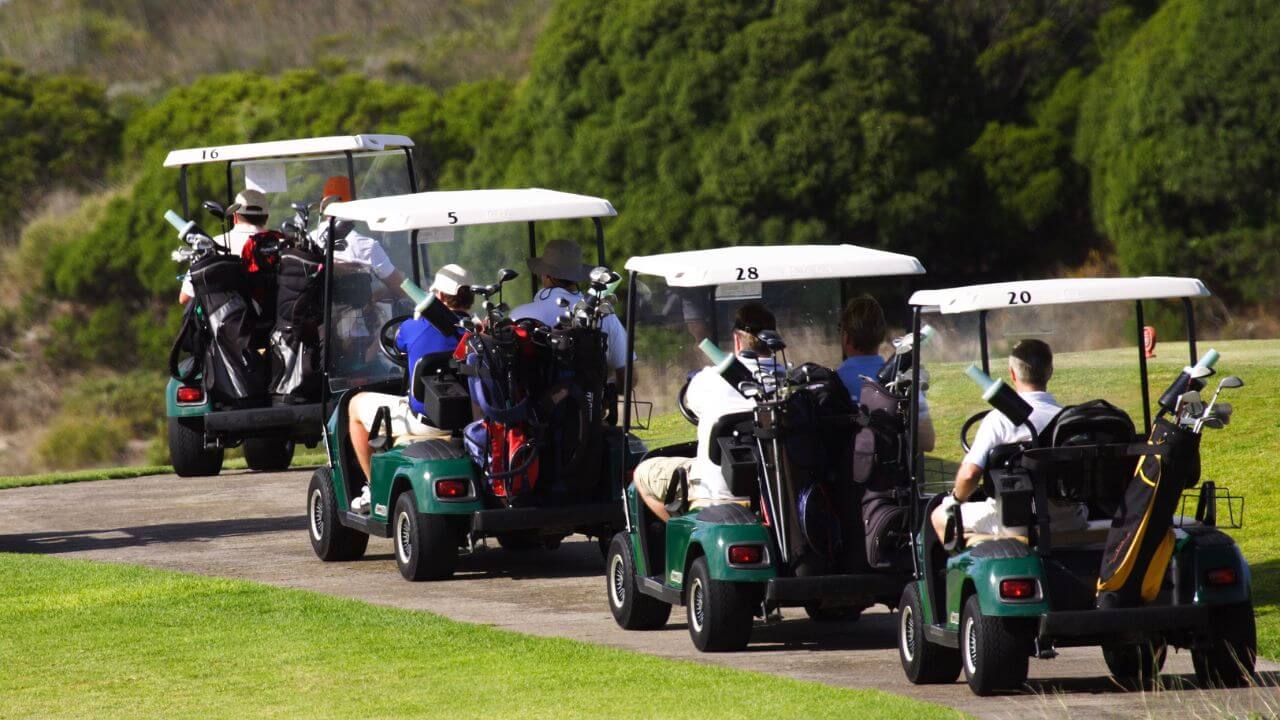Content Summary
Are you planning a day out on the golf course but are unsure and wondering, how long does 18 holes of golf take? The time it takes to play a full round of golf can vary greatly based on several factors.
An 18 hole round can take anywhere from three to five hours to play depending on the pace of play.
Expect to play at a relaxed pace of about four hours if you're playing with friends. If you're playing by yourself, you can expect to finish in under three hours.
But if you're playing golf with a group of strangers, it could take up to five hours. So, how long does it take? It all depends on your pace of play.
In this article, we will explore these factors in detail and provide some tips on how to improve your pace of play.
By the end, you'll have a better understanding of how long it takes to play 18 holes of golf and what to expect on your next golf outing. So, let's dive in!
Is it Long to Play Each Hole in Golf?
Typically, it should take about 12-15 minutes to complete a hole. But with all the various external factors it can be as much as 20 minutes.
One of the most important things to remember is that golf is meant to be enjoyed. Don’t feel like you have to rush through your round in order to keep up with the group ahead of you. Instead, take your time and savor each shot.
That being said, there are a few ways you can speed up your play without sacrificing enjoyment. Below are some suggestions you can follow to help speed up pace of play:
- Walk quickly between shots to save time without feeling rushed.
- If you hit your ball into the rough or think you have a lost ball, don't spend excessive time searching for it. It's acceptable to take a penalty stroke and move on.
- The person furthest from the hole typically hits first. Be ready to hit your shot as soon as it's your turn to avoid holding up the rest of the group.
4. Finally, be ready to hit your shot as soon as it’s your turn. If you take too long to make your shot, you’ll hold up the rest of the group.
5. Try to play ready golf. Playing ready golf is another way to speed up play without making everyone feel pressed to play quickly.
By following these tips, you can enjoy a leisurely round of golf while still keeping up with the pace of play.
What Does It Take for Amateurs to Complete 18 Holes of Golf?
As discussed above, golf is a sport that can be enjoyed by people of all skill levels. While low handicap golfers can complete a round of 18 holes in just a few hours, it typically takes high handicap amateur golfers much longer to finish a game because they have to take time to play each shot.
Depending on the speed of the golf course and the skill level of the players, a round of 18 holes can take anywhere from four to six hours to complete. However, most amateur golfers are content to spend a leisurely day out on the golf course and take their time enjoying the game.

What Does It Take to Complete a PGA Tour Round?
A PGA Tour round of golf typically takes between four to five hours to complete. However, this can vary depending on the difficulty of the course and the golfer's experience.
A difficult course or a golfer with limited experience on a particular course could push a round to last up to six hours. Conversely, a relatively easy course can be completed by pro golfers in as little as three hours with a good pace of play.
What Are the Factors Affecting a Round of Golf?
The length of a round of golf can be affected by a number of factors, including the type of golf course, the number of golfers in a group, the group in front and the use of carts.
Factors aplenty come into play to affect the length of a round of golf.
Weather can be a factor. Weather can significantly impact the speed at which golfers hit their shots, as windy or rainy conditions can cause shots to go off target and require extra time to locate and play the ball.
If the players are walking it can take longer than if they are using a golf cart. Are they having to wait on the tee box? The skill set of each player is also a factor in slow play. Higher handicap players tend to need more strokes to finish a hole.
Moreover, the skill set of each player affects the pace, with higher handicap players generally needing more strokes to finish a hole.
To speed up rounds of golf, high handicap players can move up to forward tees, which are typically closer to the hole and makes for easier second shots.
Does Using a Golf Cart Make a Difference?
The impact of using a golf cart on your round of golf can vary depending on the circumstances on the course.
In situations where the course is relatively empty, a golf cart can be highly beneficial. It enables you to set your own pace and move around the course as quickly as the cart allows, significantly speeding up your round.
This can be particularly advantageous when you have limited time to play or simply prefer a faster game.
On the other hand, when the course is busy, the benefits of using a golf cart shift from improving pace of play to enhancing comfort and energy conservation.
In these scenarios, a cart may not significantly impact the speed of your round due to the increased number of players on the course.
However, it can still be advantageous by helping you keep your legs fresh, conserve energy, and stay relaxed, especially on hot days or on courses with challenging terrain.

Choosing the Right Tees for Your Golf Game
Selecting the appropriate set of tees can significantly reduce the time it takes to play 18 holes of golf and potentially lower your scores.
To determine the ideal set of tees for you, consider using this simple guideline: Multiply the distance you typically hit your 5-iron by 36.
For example, if you hit your 5-iron 175 yards, the optimal set of tees for your game would likely measure around 6,300 yards.
However, this formula may not always be accurate, as it assumes a direct correlation between skill and distance.
For instance, a golfer who drives the ball 300 yards off the tee might still have a 25-handicap. In such cases, it's advisable to move up a set of tees and disregard suggestions to play from further back.
Additionally, you might consider leaving your driver in the bag since you already hit the ball far. Opting for a more accurate club can help improve your scores while maintaining a steady pace of play.
Does the Time of Day Impact the Pace of Play?
Indeed, the time of day when you begin your round of golf can significantly affect the overall pace of play.
If you're the first golfer to tee off for the day, you have the advantage of an empty golf course and can set the pace.
By starting the course at a brisk three-and-a-half-hour pace, you can help maintain a smooth flow for the rest of the day's golfers.
On the other hand, if you choose a tee time around 1 pm, particularly on weekends when courses are at their busiest, you'll likely encounter a slower pace of play.
By mid-afternoon, the pace on the course will have considerably decreased compared to the morning. As such, it's essential to be prepared for a longer round when opting for a mid-afternoon tee time.
Do Golf Courses Allocate Set Times Between Tee Times?
Most golf courses typically schedule tee times at intervals ranging from eight to twelve minutes apart.
Surprisingly, the pace of play tends to be faster with twelve-minute intervals compared to the tighter eight-minute ones.
When golfers tee off just eight minutes after the preceding group, they often find themselves waiting to take their shots.
These shorter tee time intervals can lead to bottlenecks, usually occurring on a challenging stretch of a few demanding holes.
In contrast, more extended intervals between tee times offer greater flexibility for unforeseen delays, such as errant shots or lost balls.
With fewer golfers on the course, you are less likely to experience long waits for those groups ahead of you, and you'll also feel less pressure from the groups behind you.
However, golf course management faces a dilemma when setting tee time intervals.
Shorter intervals allow more golfers to access the course, increasing revenue for the facility even though the overall pace of play may be slower.
Many golf courses try balancing profitability with an enjoyable golfing experience for all players which they consider a critical consideration for course management when determining tee time intervals.
Conclusion
Golf is a versatile sport that can be enjoyed by people of all ages and skill levels. It offers a fantastic opportunity to get outdoors, breathe in fresh air, and socialize with friends or make new acquaintances.
While the average round of golf takes about four hours to complete, this time can fluctuate depending on various factors, such as the number of players, course difficulty, and individual skill levels.
By understanding these factors and implementing the tips provided in this article, you can optimize your pace of play and make the most of your time on the course.
So, the next time you're seeking a leisurely activity to engage in, consider picking up a golf club and hitting the greens! With the right approach, you can enjoy a fulfilling day of golf while maintaining a comfortable and steady pace for yourself and others around you.
Thank you for visiting and we hope to see you back soon!






